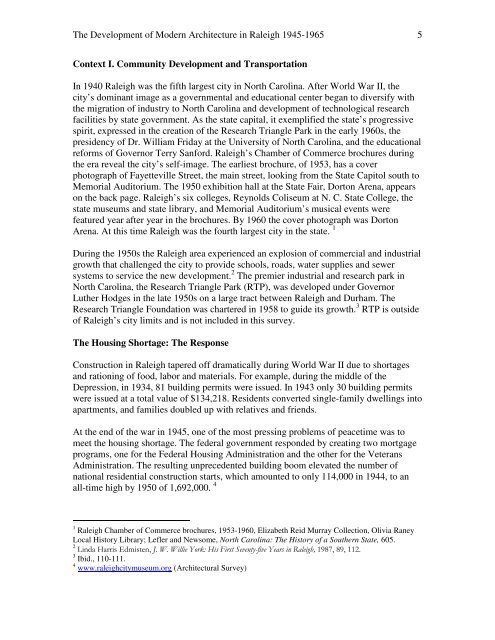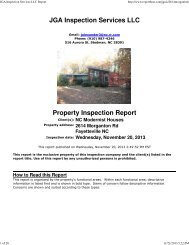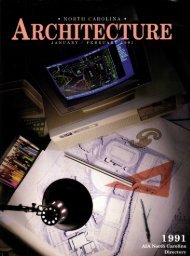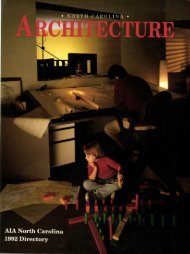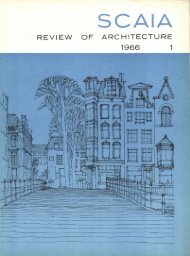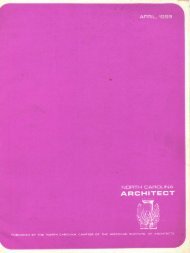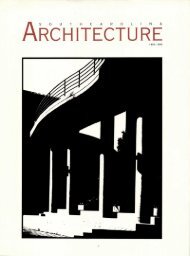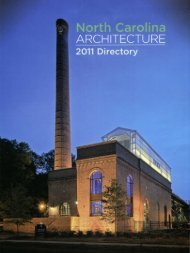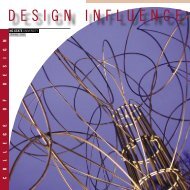The Development of Modernism in Raleigh 1945-1965 - Triangle ...
The Development of Modernism in Raleigh 1945-1965 - Triangle ...
The Development of Modernism in Raleigh 1945-1965 - Triangle ...
You also want an ePaper? Increase the reach of your titles
YUMPU automatically turns print PDFs into web optimized ePapers that Google loves.
<strong>The</strong> <strong>Development</strong> <strong>of</strong> Modern Architecture <strong>in</strong> <strong>Raleigh</strong> <strong>1945</strong>-<strong>1965</strong> 5Context I. Community <strong>Development</strong> and TransportationIn 1940 <strong>Raleigh</strong> was the fifth largest city <strong>in</strong> North Carol<strong>in</strong>a. After World War II, thecity’s dom<strong>in</strong>ant image as a governmental and educational center began to diversify withthe migration <strong>of</strong> <strong>in</strong>dustry to North Carol<strong>in</strong>a and development <strong>of</strong> technological researchfacilities by state government. As the state capital, it exemplified the state’s progressivespirit, expressed <strong>in</strong> the creation <strong>of</strong> the Research <strong>Triangle</strong> Park <strong>in</strong> the early 1960s, thepresidency <strong>of</strong> Dr. William Friday at the University <strong>of</strong> North Carol<strong>in</strong>a, and the educationalreforms <strong>of</strong> Governor Terry Sanford. <strong>Raleigh</strong>’s Chamber <strong>of</strong> Commerce brochures dur<strong>in</strong>gthe era reveal the city’s self-image. <strong>The</strong> earliest brochure, <strong>of</strong> 1953, has a coverphotograph <strong>of</strong> Fayetteville Street, the ma<strong>in</strong> street, look<strong>in</strong>g from the State Capitol south toMemorial Auditorium. <strong>The</strong> 1950 exhibition hall at the State Fair, Dorton Arena, appearson the back page. <strong>Raleigh</strong>’s six colleges, Reynolds Coliseum at N. C. State College, thestate museums and state library, and Memorial Auditorium’s musical events werefeatured year after year <strong>in</strong> the brochures. By 1960 the cover photograph was DortonArena. At this time <strong>Raleigh</strong> was the fourth largest city <strong>in</strong> the state. 1Dur<strong>in</strong>g the 1950s the <strong>Raleigh</strong> area experienced an explosion <strong>of</strong> commercial and <strong>in</strong>dustrialgrowth that challenged the city to provide schools, roads, water supplies and sewersystems to service the new development. 2 <strong>The</strong> premier <strong>in</strong>dustrial and research park <strong>in</strong>North Carol<strong>in</strong>a, the Research <strong>Triangle</strong> Park (RTP), was developed under GovernorLuther Hodges <strong>in</strong> the late 1950s on a large tract between <strong>Raleigh</strong> and Durham. <strong>The</strong>Research <strong>Triangle</strong> Foundation was chartered <strong>in</strong> 1958 to guide its growth. 3 RTP is outside<strong>of</strong> <strong>Raleigh</strong>’s city limits and is not <strong>in</strong>cluded <strong>in</strong> this survey.<strong>The</strong> Hous<strong>in</strong>g Shortage: <strong>The</strong> ResponseConstruction <strong>in</strong> <strong>Raleigh</strong> tapered <strong>of</strong>f dramatically dur<strong>in</strong>g World War II due to shortagesand ration<strong>in</strong>g <strong>of</strong> food, labor and materials. For example, dur<strong>in</strong>g the middle <strong>of</strong> theDepression, <strong>in</strong> 1934, 81 build<strong>in</strong>g permits were issued. In 1943 only 30 build<strong>in</strong>g permitswere issued at a total value <strong>of</strong> $134,218. Residents converted s<strong>in</strong>gle-family dwell<strong>in</strong>gs <strong>in</strong>toapartments, and families doubled up with relatives and friends.At the end <strong>of</strong> the war <strong>in</strong> <strong>1945</strong>, one <strong>of</strong> the most press<strong>in</strong>g problems <strong>of</strong> peacetime was tomeet the hous<strong>in</strong>g shortage. <strong>The</strong> federal government responded by creat<strong>in</strong>g two mortgageprograms, one for the Federal Hous<strong>in</strong>g Adm<strong>in</strong>istration and the other for the VeteransAdm<strong>in</strong>istration. <strong>The</strong> result<strong>in</strong>g unprecedented build<strong>in</strong>g boom elevated the number <strong>of</strong>national residential construction starts, which amounted to only 114,000 <strong>in</strong> 1944, to anall-time high by 1950 <strong>of</strong> 1,692,000. 41 <strong>Raleigh</strong> Chamber <strong>of</strong> Commerce brochures, 1953-1960, Elizabeth Reid Murray Collection, Olivia RaneyLocal History Library; Lefler and Newsome, North Carol<strong>in</strong>a: <strong>The</strong> History <strong>of</strong> a Southern State, 605.2 L<strong>in</strong>da Harris Edmisten, J. W. Willie York: His First Seventy-five Years <strong>in</strong> <strong>Raleigh</strong>, 1987, 89, 112.3 Ibid., 110-111.4 www.raleighcitymuseum.org (Architectural Survey)


